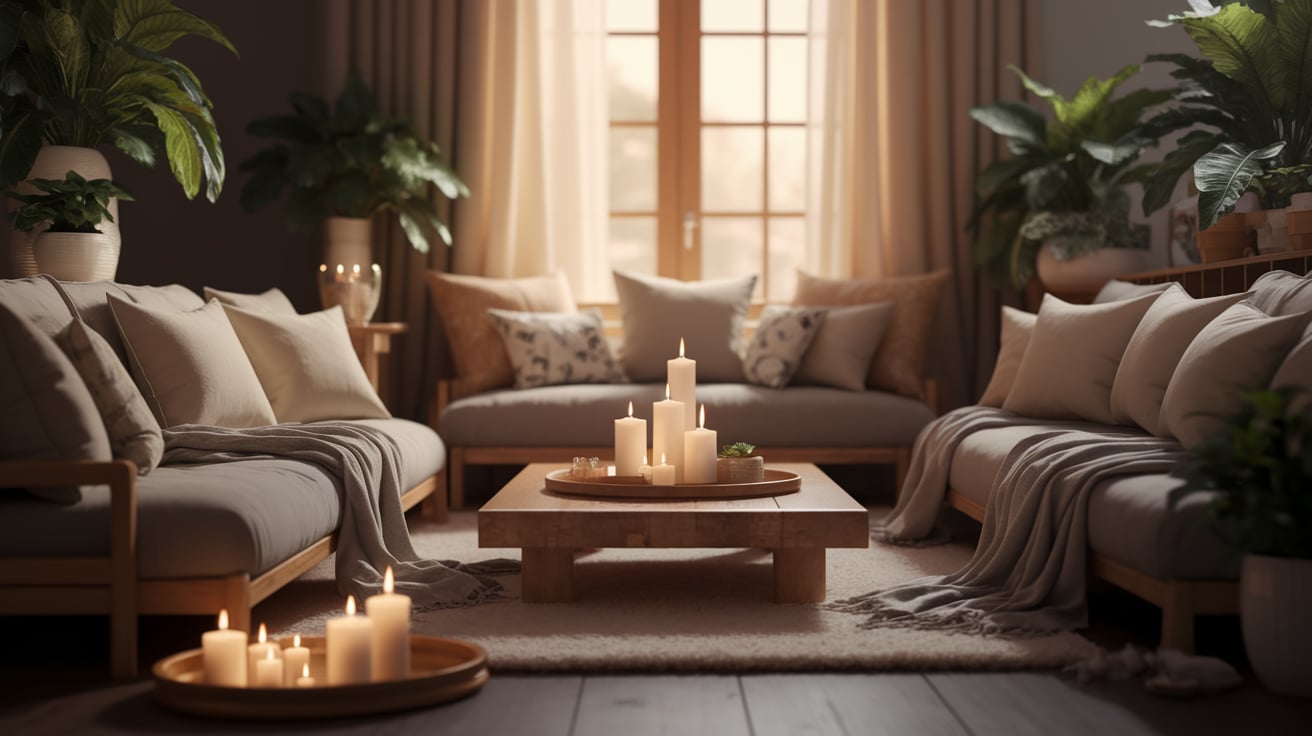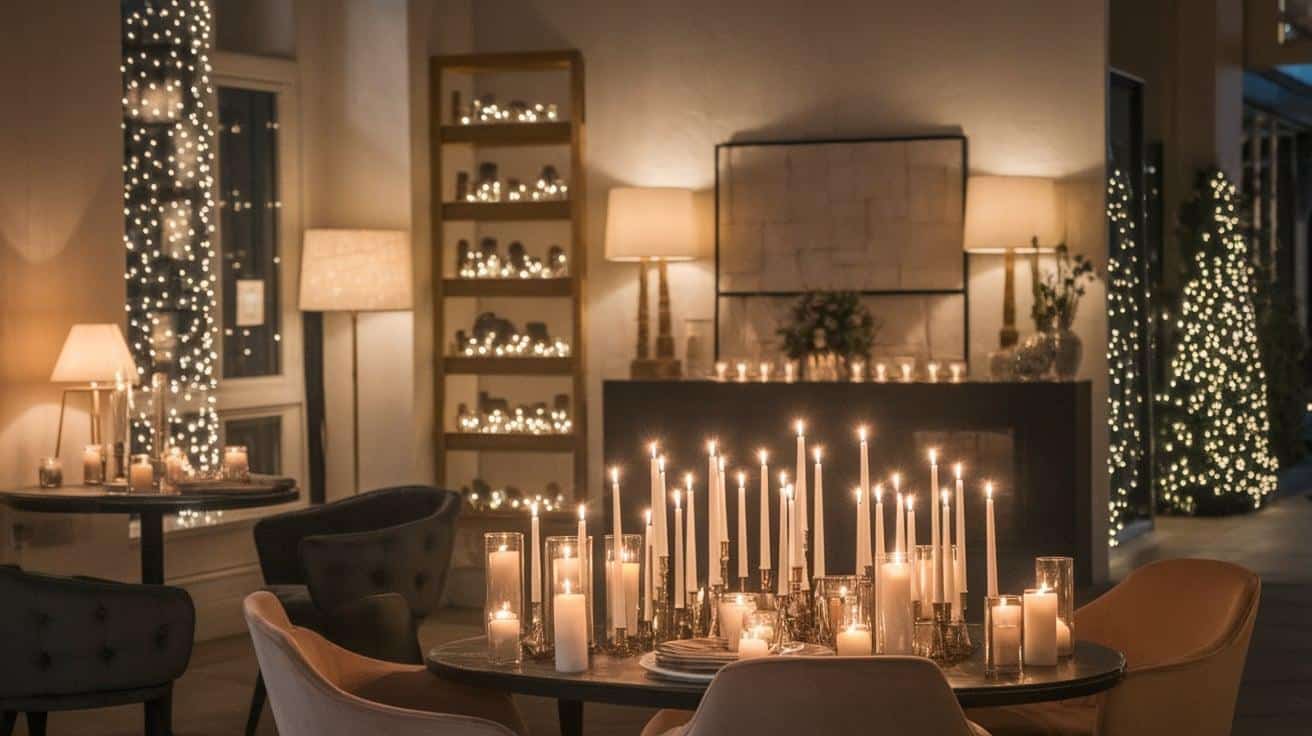Are you looking to make your home feel cozier and more peaceful?
Many of us want our homes to be places of comfort, but busy lives often leave our spaces feeling cold and empty. Creating a home that truly feels good to live in doesn’t have to be hard or costly.
Adding hygge-inspired touches to your home can turn any space into a haven of comfort and joy.
In this guide, I’ll show you how simple changes with soft blankets, warm lights, and natural materials can change how your home feels.
I’ll share 11 practical ideas that work in any home and with any budget, helping you build a space where you can truly relax and feel at peace.
What Is Hygge, and Why Does It Matter in Home Decor?
Hygge (pronounced “hoo-ga”) is a Danish concept that focuses on creating feelings of coziness, comfort, and contentment. This way of living began in Denmark as a response to their long, cold winters.
The Danes found ways to make indoor life more pleasant through simple comforts.
At its heart, hygge is about finding joy in small things. It’s the warm feeling you get when sipping hot tea under a soft blanket while snow falls outside.
It’s not about buying expensive items but creating spaces that help you feel safe and at peace.
In-home decor, hygge, brings warmth to your surroundings through:
- Simple designs that remove clutter and focus on what matters
- Soft textures like wool throws and plush pillows that invite touch
- Use warm lighting from candles and lamps instead of harsh overhead lights
- Natural materials such as wood, stone, and plants that connect you to nature
The Danish often rank as some of the happiest people in the world, and many point to hygge as one reason why. Their homes serve as sanctuaries where they can rest, connect with loved ones, and enjoy life’s simple pleasures.
Hygge’s Impact on Mental and Emotional Health
Creating a hygge-inspired home offers real benefits for your mind and mood. When you enter a space filled with soft textures, warm lighting, and simple comforts, your body naturally relaxes.
Studies show that cozy environments can lower cortisol, the stress hormone that harms our health. The soft lighting of candles or warm lamps signals to your brain that it’s time to unwind, helping you sleep better.
Hygge spaces also encourage slowing down and being present. Without the buzz of screens and noise, you can focus on the moment, the warmth of a cup in your hands, or the comfort of a soft chair.
These small moments of peace add up. They help build what psychologists call “emotional resilience” – the ability to handle life’s challenges. By giving yourself a calm home base, you create a place to recharge when the world feels too busy.
How to Mix Hygge with Your Existing Style?
Blending hygge with your current home style doesn’t mean starting over. You can add cozy elements that work with what you already have. The key is finding the right mix that feels true to both hygge and your taste.
- For modern homes: Add natural wood accents and soft textiles to balance sleek lines.
- For rustic spaces: Focus on warm lighting and handmade items to enhance the natural charm.
- For minimalist rooms: Choose a few high-quality comfort items rather than many decorations.
- For colorful homes: Incorporate neutral textiles and natural materials to create calm spots.
The beauty of hygge is how it bends to fit your life. You might love bold colors while someone else prefers all white. Both can be hygge when they include comfort, meaning, and a sense of ease.
11 Warm and Inviting Hygge-Inspired Decor Ideas
1. Cozy Textiles: Soft Blankets and Throws
Soft blankets are the simplest way to add comfort to any space. Place a chunky knit throw on your sofa and a wool blanket on your bed.
Mix different textures, such as cotton, wool, and fleece, to create more warmth. Keep baskets of throws near seating areas so guests can easily grab one.
These textiles add both visual warmth through their texture and actual warmth when the air turns cool.
2. Soft Lighting: Creating a Calm Ambiance
Bright overhead lights can make a room feel stark and cold. Replace them with floor lamps, table lamps, and string lights that cast a gentle glow.
Choose bulbs with a warm color tone (2700-3000K) rather than cool blue-toned light. Group candles together on trays for a focal point that creates moving light. The right lighting helps your body relax and signals to your brain that it’s time to unwind.
3. Natural Elements: Bringing the Outdoors In
Adding items from nature helps create a calm, grounded feeling in your home. Place small plants in ceramic pots on shelves or tables to bring life to any room.
Use wooden bowls, stone coasters, or branches in vases as simple decorations. Consider a small indoor herb garden for your kitchen window that smells good and serves a purpose.
These natural touches help you feel connected to the outside world, even when you’re inside on cold days.
4. Comfortable Seating: Relaxing Furniture
Your seating should invite you to sit down and stay awhile. Choose chairs and sofas with enough depth that you can comfortably tuck your legs up.
Add extra padding to wooden chairs with simple cushions that can be changed with the seasons. Make sure you have enough spots for family and friends to gather without feeling crowded.
Good seating forms the foundation of a room where people want to linger and talk rather than rush through.
5. Neutral Color Palettes: The Key to Hygge Vibes
Soft, muted colors create a calm backdrop that helps your mind relax. Choose whites, beiges, light grays, and soft browns as your main colors throughout the space.
Add small touches of color with plants, books, or a few carefully chosen items that make you happy. These quiet tones let your eyes rest and help other hygge elements like textures stand out more.
Paint your walls in these gentle shades to make rooms feel bigger and more peaceful.
6. Candles and Scents: Improving Atmosphere
Scent affects mood just as strongly as what we see. Unscented candles create a warm glow that makes any room feel more inviting.
If you enjoy fragrances, choose natural scents like pine, vanilla, or cinnamon that remind you of happy times. Place candles in groups on trays or shelves where they can be safely enjoyed.
Flameless candles can create similar light effects without worry for homes with children or pets.
7. Personal Touches: Displaying Memories
True hygge comes from surrounding yourself with items that tell your story. Put out a few special photos in simple frames where you’ll see them daily.
Display the quilt your grandmother made or the pottery you brought back from a trip. Keep these meaningful items where you can touch and use them, not hidden away.
These personal touches make your home unique to you and create a sense of history and belonging that no store-bought item can match.
8. Wood Accents: Adding Natural Warmth
Wood’s color and texture bring natural warmth to any space. Add wooden picture frames, serving bowls, or a small side table with visible grain.
Look for pieces with simple shapes that showcase the beauty of the wood. Even small touches, like wooden spoons in a crock or a breadboard on display, add visual warmth.
These natural materials feel good to the touch and improve with age as they develop a patina from use.
9. Minimal Shelving: Less Is More
Simple shelves with just a few items create calm rather than chaos. Choose open shelving to display only the things you find most useful or meaningful.
Leave plenty of space around objects so each one can be seen and valued. Group like items together books, plants, or pottery for a clean look.
This thoughtful approach to storage helps reduce visual noise and lets your mind rest when you enter the room.
10. Textured Rugs: Adding Comfort to Floors
A good rug makes a room feel finished and adds softness underfoot. Choose natural fibers like wool or cotton that feel nice on bare feet.
Layer smaller rugs over larger ones to create zones in bigger rooms. Pick simple patterns that won’t fight with other elements in your space.
A carpet not only makes your floor warmer but also helps control sound, making rooms feel more snug and peaceful when you’re inside.
11. Plush Pillows: Perfect for Any Seat
Soft pillows make any couch or chair feel more welcoming. , Mix sizes and textures to create spots where folks want to sit longer. Choose materials that feel good against your skin, like cotton, wool, or velvet.
These simple additions can turn basic furniture into a cozy spot for reading or chatting with friends.
Creating a Hygge Atmosphere with Color and Texture
1. Choosing the Right Color Palette for Warmth
Colors set the mood in your home and affect how you feel each day. Soft browns, gentle grays, and cream tones help rooms feel calm and warm.
Think of coffee, stones, and cloud colors that remind you of nature. Light blues and greens can work, too, much like a misty morning or calm lake. Paint walls in these mild shades to make a base that soothes your eyes.
To add more warmth, use wood tones in floors and small items. Small pops of rust, olive, or dusty rose can give rooms life without being too harsh.
2. Combining Textures for a Cozy Feel
Mixing textures turns flat spaces into ones you want to touch. Start with basic cotton for curtains or sofa covers as your base layer. Add wool throws that beg to be wrapped around your shoulders on cold nights.
Use linen for tablecloths or pillowcases for a slightly rough feel that gets softer with time. Place a fluffy rug where your feet land when you get out of bed.
Stack smooth pottery next to rough baskets on shelves. The mix of smooth and rough, soft and firm, creates depth that flat, same-feeling rooms lack. When things feel good to the touch, you spend more time truly living in your space.
The Role of Lighting in Creating a Hygge Home
1. Using Candles to Set the Mood
Candles create a soft glow that no electric light can match. Place them in groups on tables or shelves to create warm spots in a room. Mix tall and short candles for visual impact.
The moving flame catches your eye and helps your mind slow down. Unscented ones work well for dinner tables, while mild scents can boost your mood in living areas and bedrooms.
2. The Warmth of Ambient Lighting
Table lamps cast pools of light where you need them most. Place them near reading chairs and beside sofas to create cozy zones. Floor lamps can wash walls with a soft glow that makes rooms feel larger.
Avoid harsh ceiling lights when possible. String lights tucked along shelves or draped around windows add a touch of magic to simple rooms.
Incorporating Hygge in Every Room of Your Home
1. Hygge Living Room Ideas
Could you make your living room a place people want to stay? Group chairs and sofas so they face each other for better conversations. Keep throws within arm’s reach on hooks or in baskets.
Use lamps instead of bright overhead lights. Add a low coffee table for hot drinks. Put books and games where they’re easy to grab. Leave some clean space for minds to rest without clutter.
2. Hygge Bedroom Ideas
Your bedroom should feel like a quiet cave. Use thick curtains to block outside light when needed. Put a soft rug beside your bed for warm feet in the morning.
Layer sheets, quilts, and throws for perfect warmth. Keep books on your bedside table. Remove work items and screens when possible. A small plant brings life without taking up much space.
3. Hygge Kitchen and Dining Room Tips
The kitchen should smell good and feel warm. Keep tools you use often within easy reach. Hang mugs on hooks for quick tea or coffee breaks. Use wooden boards and cloth napkins at meals.
Have a bowl of fruit where people can help themselves. Make sure the chairs are comfortable enough for long talks after eating. Add a small lamp to counter space for night snack trips.
Conclusion
A cozy home doesn’t need fancy items or perfect design. It requires your touch and care. The small changes we’ve talked about- soft pillows, warm lights, and gentle colors- all work together to create spaces that help you feel better.
These ideas work in any home and on any budget. What matters most is how your home makes you feel when you walk through the door.
Does it help you breathe easier? Does it give you a place to rest? Try just one or two ideas from this post this week. Add a blanket to your couch or swap bright bulbs for softer ones.
Notice how these small shifts change how you feel in your space. Your home should fit you, not the other way around.
























